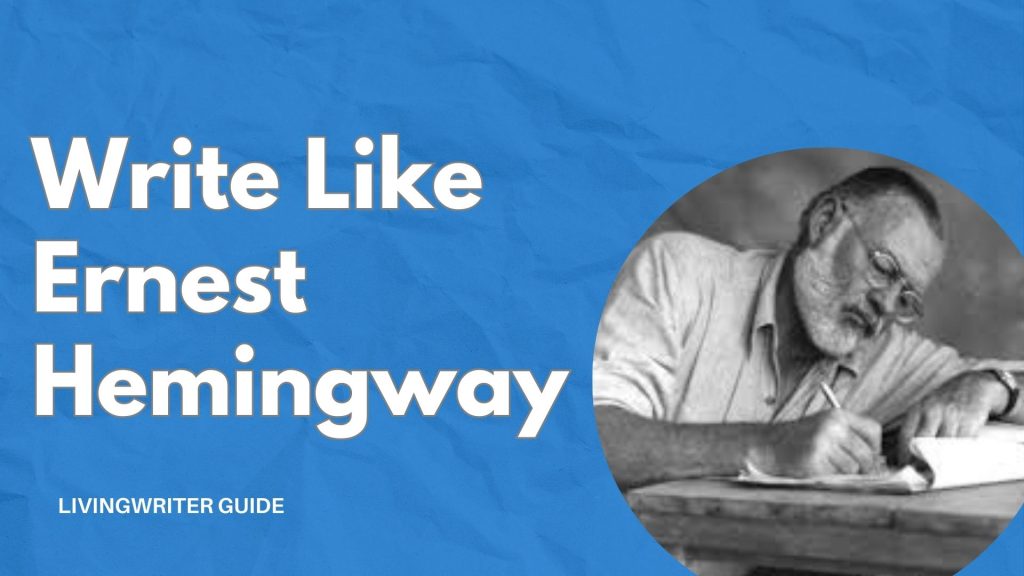Ernest Hemingway Writing Advice – 8 Great Tips

Ernest Hemingway’s writing style is simple, direct, and highly effective. Combined with the themes of courage, loss, and the human condition in the face of adversity, it has created a powerful and lasting impact on literature. The man could write.
And while not known for his formal “how-to” guides on writing, he has some fantastic advice scattered throughout his works, interviews, and letters. So, today, we will be looking at some invaluable Ernest Hemingway writing advice.
From character inspiration to subtext, editing, and his famous “iceberg theory,” Hemingway said a lot we can learn from. So, without further ado, let’s get into eight writing tips from Ernest Hemingway that you don’t want to miss.
Table of Contents
Ernest Hemingway Writing Advice
Hemingway never wrote a formal “On Writing” style guide to the craft. Instead, his advice of simplicity and directness, honesty, observation of details, omission, discipline, and hard work come from a few key sources.
Most of the advice you’ll find below comes from the following sources:
- Death in the Afternoon: Although primarily about bullfighting, this non-fiction work contains some of Hemingway’s most direct pronouncements on writing.
- A Moveable Feast: This memoir of his time in Paris in the 1920s offers valuable insights into his early writing process, daily writing routine, struggles with writer’s block, and philosophy of writing “one true sentence.”
- Interviews and Letters: Hemingway gave numerous interviews throughout his career, often discussing his writing methods and beliefs. And his letters to friends, editors, and fellow writers also contain valuable advice and insights.
1. Writing “Must Haves”

A Moral Compass
Starting off, there are three things that Hemingway said every writer should have. The first is a strong moral compass. In other words, a strong sense of justice, right and wrong, whatever you want to call it, it powers writing.
To Use Pain
The next is to use your pain in a productive and truthful way. I’ve heard people say that Hemingway said you have to have childhood trauma to be a writer – This isn’t quite true. In a 1934 letter to F. Scott Fitzgerald, Hemingway said:
“Forget your personal tragedy. We are all bitched from the start and you especially have to be hurt like hell before you can write seriously. But when you get the damned hurt, use it—don’t cheat with it.”
Hemingway focused a lot on truth in his writing. As such, he believed that genuine emotional depth could only come from real experiences, and that doesn’t exclude difficult ones. So, the key part of the quote is, “Use it—don’t cheat with it.”
So, don’t get hung up on poorly paraphrased statements like, “You can’t be a writer without childhood trauma.” Draw on your own experiences, whatever they are, including the painful ones. We may all have different struggles, but we’ve all got them. Or, in other words, as Hemingway said, “We are all bitched from the start…”
A Shit Detector
Pardon the French here. The full quote is, “The most essential gift for a good writer is a built-in, shockproof shit detector.” This is a colorful way of saying that a good writer needs to have good judgment and a strong sense of what works and what doesn’t.
In other words, be a truly critical reader of your own work and have the courage to cut out anything that doesn’t feel genuine or true. It’s about striving for clarity, precision, and authenticity in your writing. This can be applied to characters, sentimentality, and bad writing in general. And most importantly, editing!
2. Pick A Strong Subject

Hemingway suggest writers find a strong main topic for the story they’re going to write. He gravitated toward big themes—war, love, loss, death—because they mirror life’s most intense experiences. Writing about any core elements of human existence gives you a built-in emotional center that resonates almost universally.
You May Also Like: How To Get Ideas For Writing – 6 Must-Know Tips
As a result, you’ll often find that you need less elaborate language to make readers feel deeply; the inherent gravity of certain “big themes” allows your words to hit home even if your sentences are spare. But the grand scale of the theme should be boiled down to a character’s personal view, too. Here are some tips on this:
- Start with a massive idea, like war or love, but filter it through one character’s intimate viewpoint.
- Show how the larger conflict or theme disrupts that person’s world rather than just describing the grand scale of events.
- Use small, concrete details that illustrate the bigger idea on a human level.
3. How To Start (And Avoid Writers Block)

In A Moveable Feast, Hemingway famously wrote, “All you have to do is write one true sentence. Write the truest sentence that you know.” He believed that if he could pin down one undeniably true statement, it would anchor the authenticity of everything that followed.
He came to this conclusion after getting writers block in Paris. And it’s a great guiding principle for breaking through writer’s block—focus on an indisputable fact about your character, setting, or conflict and then build outward from there.
This principle of building an entire honest story from a single cornerstone sentence was impactful enough to warrant an entire book on the subject, One True Sentence: Writers & Readers on Hemingway’s Art, in which various authors select and examine a single sentence of Hemingway.
4. How To Write A Good Character

In terms of characters, Hemingway focused on the idea that they shouldn’t be perfect, that they should feel like real people rather than fictional, and he often drew from real individuals he knew to help with this.
No Perfect Characters
If you find your character sliding close to “perfect” territory, give them a moment where they fail, hesitate, or face a moral dilemma they don’t handle gracefully. Even just a momentary lapse goes a long way toward an authentic character.
You May Also Like: How To Write Unique Characters With LivingWriter
Another tip for more real, three-dimensional characters is to give them conflicting traits or emotions. For instance, a soldier might be outwardly brave but internally plagued by self-doubt, or a caring friend might make a selfish choice in a moment of weakness. These small paradoxes add depth.
Basing Characters on People You Know
Hemingway drew heavily on people he encountered in his own life, and you can, too—friends, lovers, mentors, and even people you don’t like. Observe things like their mannerisms, speech patterns, and personal struggles, then rework those details into your fiction.
Get into the practice of “people-watching” and note how people react under stress or speak in heated conversations. Once you practice this, you’ll find that you can take something memorable from every encounter you have and use these small, unique details to enrich backstories or character personalities.
It’s important to remember that fiction is often inspired by reality, but it’s not a direct transcription of it. Hemingway used real people and events as a starting point, but he also fictionalized and embellished them.
Craft Compelling Characters with LivingWriter
Even basing characters on people you know, writing truly memorable characters is still hard. But LivingWriter, your one-stop writing companion, can help you overcome this hurdle. Ditch the generic traits and breathe life into your characters with LivingWriter’s unique features.
Character AI Tools allows you to start with some basic info on what you’re looking for and get a character profile back in a matter of moments. And LivingWriter AI is designed to help writers do their best work, not write it for them. So, don’t expect generic, “soulless” AI here.
Then, use the Manuscript Chat Features to refine characters. Once you’ve created some characters, you can chat directly with your manuscript to ask research-based, theoretical, or logistical questions about your plot and characters.
The chat understands your entire manuscript and everything within and gives you feedback tailored directly to your story. So, you can ask things like, “How do I make ‘Chacater A’ more interesting?” and it will give you advice on that specific character in the context of your story.
5. Be Detailed

Hemingway was stingy with details but believed the ones he did include made the book feel alive. He emphasized the importance of careful observation and selecting the right details to create a vivid and authentic experience for the reader. When you detail the right things, a lot can be inferred without needing to be directly stated.
Hemingway summed this idea up with his “Iceberg Theory,” where he said:
“If a writer of prose knows enough about what he is writing about he may omit things that he knows. The dignity of movement of an ice-berg is due to only one-eighth of it being above water. A writer who omits things because he does not know them only makes hollow places in his writing. He should have knowledge of those things and not deal with them.”
He’s basically describing the use of subtext in writing, which requires you to have a deep understanding of your plots and characters. When you have a thorough understanding of what’s beneath the surface of an action or piece of dialogue, you can convey a lot more than what’s on the page.
For example, take a section like, “They left the theater, the woman walking slightly ahead, her shoulders slumped. The man trailed behind, kicking at a loose stone on the sidewalk.” By adding small details of their posture and actions, the reader could infer that they’ve had an argument or that something is off without a detailed description of the fight.
Continuing from the quote above and expanding on this use of selective details, Hemingway says:
That is easy to test. When you are writing someone walking up to a house, for instance, if you know what the house and the street and the town look like, and what time of year it is, you can omit all of that, and it will be there. The more you omit, the more the story or novel is strengthened.
Overall, this advice emphasizes the following key points:
- Observation is Crucial: Pay close attention to the world around you, especially people’s behavior and interactions.
- Internalize and Filter: Don’t just note what you see; process it and understand the underlying emotions and motivations.
- Omit the Unnecessary: Only include the details that are essential to conveying the meaning and emotion of the scene.
- Trust Your Knowledge: If you truly understand the subject, you can omit many details without losing clarity or depth.
6. Keep It Simple

Hemingway was a master at keeping it simple. He suggested that writers be neat, simple, and short, even with complex things. Again, he credits this ability to truly “knowing” the subject you’re writing about, both inside and out. When you understand something deeply, you can explain it easily.
Speaking on this skill, he said:
“It is all very well for you to write simply and the simpler the better. But do not start to think so damned simply. Know how complicated it is and then state it simply.”
This quote connects directly to his Iceberg Theory. The writer’s deep knowledge is the submerged part of the iceberg, while the simple prose is the visible tip—simplicity is only effective because of the underlying complexity.
So, don’t mistake simplicity for shallowness. Remember, you’ve got to know it all and write just enough to convey it all. This often means overresearching, overwriting, and then leaving a lot of it out. Write it all and delete what you don’t need later.
7. Write With The Body, Not Mind

Hemingway believed good writing comes from the body more so than the mind. So, what does it mean to “write with the body” instead of the mind? Well, according to a quote I will share below, he essentially means to keep it real and tell it how it is. And to not let the idea of “being a writer” and flowery prose detract from the truths of your story, even if they’re harsh.
Here’s the relevant passage:
“I was thinking how some writers were spoiled by having been told early that they were writers. This makes them think that writing is something very precious and that they are the vessels, and this takes away their guts so that they cannot write about the belly the way it is, nor the testicles either, nor the way a woman truly feels; they have nice clean minds, you see, and they are truly dead.”
Hemingway was known for his sometimes harsh criticisms of other writers, even other big names of the time. In this quote, he criticizes writers who are overly precious about their work and afraid to confront the more visceral and uncomfortable aspects of human experience.
He’s saying their minds are sterile and detached from the real world. That they lack the necessary experience (or willingness) to confront the messy, uncomfortable truths of life, which, in Hemingway’s view, makes their writing lifeless and inauthentic.
While that is the core message here, I have a few tips to add to the “keep it real and tell it how it is” advice. First, use all five senses when you write. Describing how things smell, taste, or sound, where possible, is writing with the body.
Secondly, don’t be afraid to trust your gut. If you’ve developed that “built-in, shockproof shit detector,” as Hemingway put it, trust it, even when it doesn’t align with how a writer should write or whatever initial vision you had for the story you’re working on.
8. Wait To Revise

Hemingway strongly advocated for putting significant distance between the first draft and the revision process. He didn’t believe in finishing a piece and immediately diving into edits. Instead, he recommended letting the work rest longer than you might initially think necessary.
For A Farewell to Arms, he famously waited a month before even considering revisions. This distance allows you to approach your work with fresh eyes, see it more objectively, and identify issues you might have missed before.
He also practiced what he preached; he rewrote the ending of A Farewell to Arms a staggering 47 times. This illustrates a crucial point: all writing is rewriting. If a master like Hemingway felt the need for 46 revisions, it’s pretty clear that persistent revision is not a sign of failure. So, keep that BS detector tuned up, and don’t be afraid to keep revising until you’ve achieved the desired result.
Conclusion
There you have it, my friends, the most established of Ernest Hemingway’s writing advice. If you’re a fan of his work, you’ll know that these are all things he very much actually did in his own writing. I hope you find the advice as helpful as I have. Until next time, get out there and get to writing.